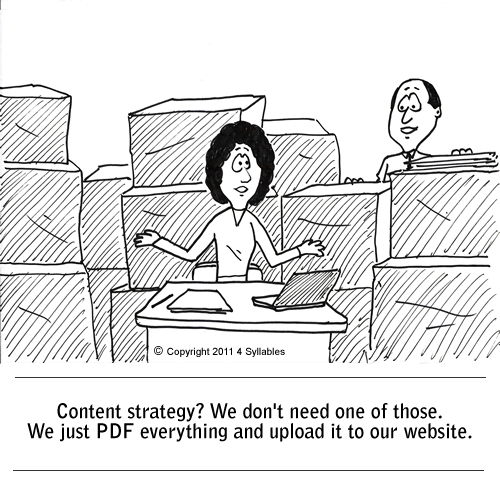Once upon a time, Sara worked as a web content strategist in a medium-sized organization. She sat in the web department, but she had convinced everyone across the organization that content should be prioritized. Everyone agreed for the most part to follow her recommendations on where content should go and when it should go live. She had two people working with her to help with this, as well as support from the rest of the web team. (See blog footnote for a definition of web content strategy).
For many of us working in this field, this sounds like a fairytale. It is. For those who don’t spend their lives thinking about online communications, it probably sounds like it shouldn’t be that difficult.
Can you imagine an accountant having to convince people in other departments that certain numbers in his spreadsheets matter? Would an engineer have to negotiate with her entire company how a part for a crane would be designed? Would you feel comfortable telling a surgeon where and how to make an incision? Somehow, though, everyone thinks they know what should go up on their organization’s homepage.
Why is content strategy so subjective sometimes? Why is it so hard to convince people slapping PDFs on a website is often a bad idea? Or that the navigation should be consistent and not change very few pages? Or that paragraphs should be kept shorter than book-length, that there is no need to tell people to “click here,” just hyperlink the appropriate text, or that there shouldn’t be 20 items on the homepage, all written in 10-point font to fit. Even these basic rules can be a battle.
If you’re new to web content strategy, are you just realizing it’s more about people, not content, than you ever imagined? The hard part of content strategy is not what you think; it’s not the content or the strategy part. It’s the people part.
Does some of this make sense? Where are you in terms of creating a web content strategy? Do you have a website where staff have just dumped content to deal with later? Do you have many people owning the site? Or do you have a neglected site? Or a combination of any of the above?
I’m not sure I’m a big fan of using the words website redesign any longer. It sort of says there’s a start and a stop to your website, but there isn’t. Working on your website is a continuous process. It doesn’t stop. That’s sort of how I wanted to set up the infographic I made. You move around the circle from one stop to another. It is a process.
The problem is that some people don’t understand it that way. They see it as, let’s do a website refresh or redesign, then the job is done. However, as you will see in the circle, there are always continuous updates.
And when you’re actually working on moving to a new site, there is so much going on that the content side often isn’t thought about until the end. Because content is easy to write, post and figure out right? Of course not! But sometimes we’re the only ones who know that.
We have to keep pushing that message out all the time. Content is easily forgotten, no matter how often we say it. This, of course, is a major problem because really the content should be first and foremost. Content is why people come to your online site, right?
As content strategists, if our job was just to focus on the content and the strategy, our job would be easy. But the hardest part of content strategy is making sure everyone on the project is on board with making content a priority.
It is a ongoing job to promote the importance of spending the time figuring out how content should be created, where to place content, and how often it should be updated. That’s the hard part. Actually, laying out the content strategy is much easier.
Stay tuned for details about how to do the fun part of your content strategy. It’s the part that deals with content and strategy.
Footnote
I expect some of you are thinking, what the heck does content strategy even mean? Let’s break it down. So, what’s part of a web content strategy, or plan?
As I wrote in the first part of this website strategy series, “Strategy is broad, and it can be a bit abstract. But I’m going to break it down for you. A strategy is a plan. It’s a plan that lets you determine how you’re going to reach your goal (whether that’s maintaining your website, updating it or redesigning it completely).
Strategist Kristina Halvorson sums it up nicely in her must must-read book if you’re in this field, “Content Strategy for the Web.” She writes that there are four components to the core strategy: substance, structure, workflow, and governance. Substance is about your message, structure is about how your content is prioritized and displayed, workflow is about ensuring a smooth process and quality control, and governance refers to to who and how overall decisions are made, and how this information is communicated.
